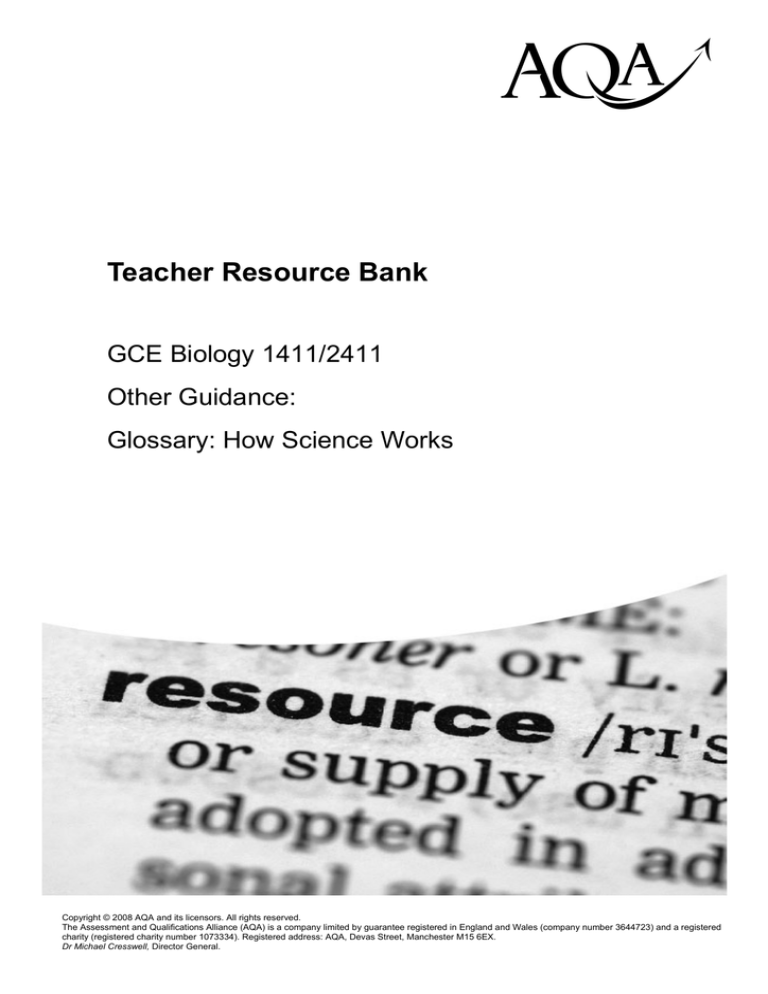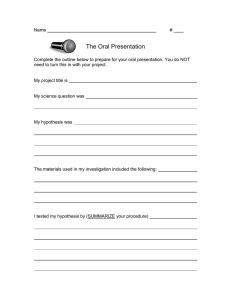
hij
Teacher Resource Bank
GCE Biology 1411/2411
Other Guidance:
Glossary: How Science Works
Copyright © 2008 AQA and its licensors. All rights reserved.
The Assessment and Qualifications Alliance (AQA) is a company limited by guarantee registered in England and Wales (company number 3644723) and a registered
charity (registered charity number 1073334). Registered address: AQA, Devas Street, Manchester M15 6EX.
Dr Michael Cresswell, Director General.
Teacher Resource Bank / GCE Biology / Glossary: How Science Works / Version 1.0
GLOSSARY: HOW SCIENCE WORKS
Accuracy
An accurate measurement is one which is close to the true value.
Anomalous data
Anomalous data are those measurements that fall outside the
normal, or expected, range of measured values. Variation is a
characteristic of all living organisms, and it is often difficult in
biological investigations to distinguish between data that reflect this
variation and those that are genuinely anomalous. A large number of
readings allows anomalous data to be identified with greater
certainty.
Calibration
When using a measuring instrument, calibration involves fixing
known points and constructing a scale between these fixed points.
Causal link
A change in one variable that results from or is caused by a change
in another variable.
Chance
Chance is essentially the same as luck. If a coin is tossed in the air,
whether it comes down heads or tails is purely due to chance. The
results of any investigation could have a genuine scientific
explanation but they could be due to chance. Scientists carry out
statistical tests to assess the probability of the results of an
investigation being due to chance.
Confounding
variable
A confounding variable is one that may, in addition to the
independent variable, affect the outcome of the investigation.
Confounding variables must be kept constant or the investigation will
not be a fair test. In some investigations, ecological investigations in
particular, it is not always possible to keep confounding variables
constant. In such cases, these variables should be monitored. In this
way it may be possible to decide whether or not the factor
concerned affects the outcome of the experiment. Confounding
variables are sometimes referred to as control variables.
Control experiment A control experiment is one that is set up to eliminate certain
possibilities. In a well designed investigation, the independent
variable is changed and all confounding variables are kept
constant. The possibility exists, however, that something else other
than the independent variable might have produced the results that
were obtained. A control experiment is one that is designed to
eliminate this possibility.
Control group
A control group is one that is treated in exactly the same way as the
experimental group except for the factor that is being investigated.
This allows scientists to make a comparison. It ensures that the data
that are collected are valid because any differences between the
results for the experimental group and those for the control group
will be due to a single independent variable.
Control variable
See confounding variable
klm
Copyright © 2008 AQA and its licensors. All rights reserved.
1
Teacher Resource Bank / GCE Biology / Glossary: How Science Works / Version 1.0
Correlation
A correlation shows that there is a relationship between two
variables, however, it might not be a causal one.
Dependent variable The dependent variable is the variable the value of which is
measured for each change in the independent variable.
Double-blind trial
A trial, usually used in the context of medicine, when assessing the
effects of a new drug or treatment on humans. Neither the patients
nor the scientists concerned know which treatment a particular
individual is receiving until after completion of the trial. This helps to
avoid bias and increase the validity of the trial.
Errors
Errors cause readings to be different from the true value.
Evidence
The data or observations that are used to support a given
hypothesis or belief.
Fair test
A fair test is one in which only the independent variable has been
allowed to affect the dependent variable. A fair test can usually be
achieved by keeping all other variables constant or controlled.
Hypothesis
Sometimes known as an experimental hypothesis, this is a possible
explanation of a problem that can be tested experimentally.
Independent
The independent variable is the variable for which values are
changed variable by the investigator.
Null hypothesis
A statistical test requires a clear hypothesis to test. It is often
difficult to predict what would happen as the result of an
investigation. It is much easier to phrase a hypothesis in terms of
there being no difference or no association. A hypothesis worded in
this way is called a null hypothesis. As the result of carrying out a
statistical test, a decision can be made about whether to accept or
reject this null hypothesis.
Placebo
A placebo is a dummy pill or injection given to members of a control
group in medical trials. Where a placebo is in the form of a pill, it
should be identical to the pill used with the experimental group. The
only difference should be that that the placebo does not contain the
drug being trialled. The use of placebos helps to ensure that the
data collected from a trial are valid.
Precision
Precision is related to the smallest scale division on the measuring
instrument that is being used. A set of precise measurements will
have very little spread about the mean value.
Probability
Probability is the likelihood of an event occurring. It differs from
chance in that it can be expressed mathematically. In statistical
tests, probabilities are usually expressed as a decimal fraction of
one. Thus a probability of 0.05 means that an event is likely to occur
5 times in every 100.
Protocol
Once an experimental method has been shown to produce valid
and reliable results, it becomes a protocol used by other scientists.
2
Copyright © 2008 AQA and its licensors. All rights reserved.
klm
Teacher Resource Bank / GCE Biology / Glossary: How Science Works / Version 1.0
Random
distribution
A random distribution is one that arises as a result of chance. When
investigating, for example, variation in living organisms, the data
collected will only be valid if they have been collected at random.
This avoids observer bias and allows statistical tests to be used in
an analysis of the results of the investigation.
Random errors
Random errors occur in an unpredictable way. They may be caused
by human error, faulty technique in taking measurements or by faulty
equipment.
Raw data
Raw data are instrument readings and other data collected at the
time of the investigation. These data may subsequently be
processed and used to calculate percentages and standard
deviations.
Reliability
The results of an investigation may be considered reliable if they can
be repeated. If other scientists get the same results, then the results
of the initial investigation are more likely to be reliable. The reliability
of data within a single investigation can be improved by carrying out
repeat measurements.
Systematic errors
These errors cause readings to be spread about some value other
than the true value. In other words, all the readings are shifted in
one direction from the true value. Systematic errors may occur when
using a wrongly calibrated instrument.
True value
This is the accurate value which would be found if the quantity could
be measured without any errors.
Validity
Data are only valid if the measurements that have been made are
affected by a single independent variable only. They are not valid if
the investigation is flawed and control variables have been allowed
to change or there is observer bias. Conclusions are only valid if
they are supported by valid and reliable data measured to an
appropriate level of accuracy.
Zero errors
Zero errors are caused by instruments that have an incorrect zero. A
zero error may occur when the needle on a colorimeter fails to return
to zero or when a top-pan balance shows a reading when nothing is
placed on the pan.
klm
Copyright © 2008 AQA and its licensors. All rights reserved.
3

